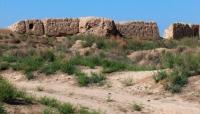Вы здесь
Geoksyur settlement.

Tours on jeeps on archaeological sights of ancient Merv.
"The citadel (kukhendiz) in size is similar (internal) city of (Medina), only it become empty, it high and, despite an eminence, underground channels of water which flows up to now are carried out to it; on it a melon field, kitchen gardens and other sometimes get divorced. As for markets, in old times gate (internal) city of (Medina) had them, sideways from "the old mosque", and in days by Abu-Muslim are postponed for Madzhan. Merv markets the purest"
"Kitam Mesalik Al-Memalik. Merv" Al-Istarkhi.
Excursions across ancient Merv.
The extensive settlement in the old delta of the Tedzhen River relating to the IV millennium BC. It is located nearby, from the station Geoksyur (between Tedzhen and Mary). The area of a monument reaches 12 hectares with a height over 10 meters over the surrounding area.
The settlement consisted of the multiroom houses divided by narrow small streets. All houses are built from a standard, rectangular adobe brick. The material culture of Geoksyur differs in the magnificent painted thin-walled ceramics decorated with a difficult and multi-color geometrical ornament.
In this regard the ceramics of Geoksyur style differs from modern ceramics of other areas of ancient Turkmenistan markedly. One more feature of Geoksyur is production of tiny female figurines from the burned clay with type always of the sitting terracotta figures quite often with difficult high hairstyles.
The same persons always have the big, acting noses perhaps transferring anthropological type of the population. Along with such numerous sculptures there are also men's images, is frequent with fighting helmets on the heads.
If female figures symbolized the goddess-mother, then men's, most likely transfer images of military leaders or leaders. The third feature of Geoksyur is funeral constructions earlier unknown here in the form of dome hollow tombs with group burials (tolos).
Perhaps, they served as some kind of family crypts. People probably got to Geoksyur in the course of breeding resettlement from regions of Southwest Iran and, perhaps, Mesopotamia. Around Geoksyur in the ancient delta of Tedzhen there were some more settlements.
Nine of them are investigated by archeologists, and some received national names. It to Dashlydzhi-depa, Akcha-depa, Ayna-depe, Yalangach-depa, Mullali-depa and Chong-depa. Together they made once fertile Geoksyur an oasis which inhabitants were among pioneers of construction of irrigation canals.
In any case, the traces of irrigational network of an era of an eneolit found here - one of ancient in the world. By means of the artificial canals allocated from riverbeds of Tedzhen about 50 hectares were irrigated that guaranteed to Geoksyurs rather steady harvests of barley.
Settlements of an oasis throughout many centuries of existence underwent evolution from the strengthened villages with one-room huts to settlements from set of the quarters, more difficult on planning, which are built up with multiroom houses.
Authority:
Bernshtam A.N. «History-archeologic sketches Central Tien-Shan and Pamir-Alay». « Religious and spiritual monuments of the Central Asia».
Photos
Alexander Petrov.







